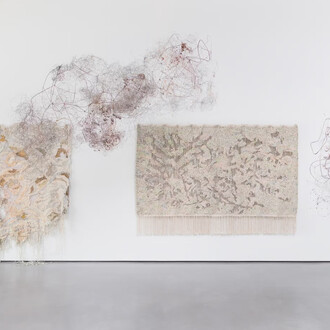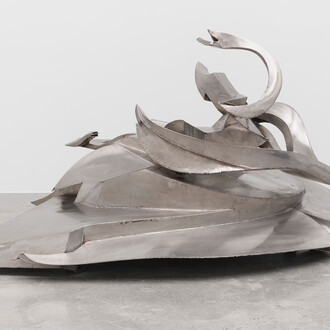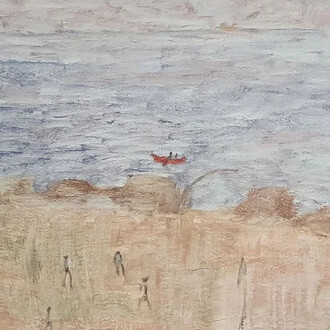Aliona Ortega Fine Art is pleased to present “Black & White”, a group exhibition featuring works by Jose M. Arellano (USA/b. Cuba), Ronald Dupont (Belgium), Jorge Enrique (USA/b. Cuba), Luis Garcia Nerey (USA/b. Puerto Rico), L’Atlas (France) and Joe Segal (USA). Curated as an artistic dialogue between monochromatic artworks, the exhibition explores the profound impact of black and white (and all shades of grey in between). Through an array of paintings and sculptures spanning diverse mediums such as oil on canvas, acrylic on board, tar, resin, spray paint, carbon fiber, and wood, the show encompasses a spectrum of styles including realism, abstraction, kinetic “reverspective” (reversed perspective), and street art.
By stripping away the distraction of color, black and white imagery forces us to focus on the formal values of the artwork – contrast, texture, movement, subject matter, and concept. This limited palette introduces a simplicity and directness often lost if the image is in full color. Black and white, and its infinite number of gradations, somehow conveys emotion in a way that color images simply cannot.
The visual impact of black and white is immediately felt in the monochromatic "reverspective" wall installations created by Miami native Jose M. Arellano. Optical illusions on three-dimensional surfaces mesmerize and bewilder the observer's eyes. Arellano's pieces, characterized by the illusion of motion (also affected by the play of light), compel viewers to engage actively by swaying side-to-side or stepping forward and backward.
Abstract artists, who restrict their palette to black and white, often do so as a minimalizing and focusing tool to lead the viewer toward intellectual or philosophical considerations. With no references to external reality, abstract works are not necessarily impersonal or detached, but instead, may be deeply emotive and powerful. We see the artists’ hand in the texture of the paint and in the subtle variations of tonalities.
In 1915, the great Kyiv-born avant-garde artist Kazimir Malevich (Russian, 1879-1935) created his revolutionary work “Black Square” featuring a black square suspended within a white field. For Malevich, this represented the zero point in art, marking the departure from representational to abstract painting. Malevich's pioneering works and theoretical writings profoundly shaped the evolution of abstract art throughout the 20th century. Through his concept of Suprematism, Malevich aimed to forge a mode of expression that distanced itself from the constraints of natural forms and subject matter, aspiring instead to attain "the supremacy of pure feeling" and spiritual transcendence.
The essence of pure feeling is expressed in the deeply evocative abstractions of Luis Garcia Nerey (USA/b. Puerto Rico, 1973), the urban poeticism and street energy of works by Jorge Enrique (USA/b. Cuba, 1957), and the harmonious proportions of the golden ratio evident in the minimalist sculpture of Joe Segal (USA, b. 1963). –- all underscored by the artists' deliberate use of a minimal palette in the artworks showcased in the "Black & White" exhibition.
Since the arrival of photography in 1839 and film in 1895, painters have been influenced and inspired to imitate their visual effects. Belgian artist Ronald Dupont's (Belgium, b. 1961) work is informed by photography, satellite imagery, drone technology, and electronic mapping. His depictions of urban landscapes often present innovative interpretations akin to satellite or aerial views. Dupont's paintings exhibit an astonishing photographic realism from afar, showcasing impeccable proportions and compositions. Upon closer inspection, viewers discern subtle blurs and smudges – the evidence of the artist’s hand -- leading toward a gradual and flawless transition into abstraction.
Juxtaposed beside Dupont’s bird’s-eye view of New York City is the geometric calligraphy of street and video artist L'Atlas (France, b. 1978), who studied calligraphy, typography, and film. Transitioning from Parisian streets, where he tagged walls and facades with distinctive repetitive patterns, L'Atlas's work has now found its way into galleries, and into major national commissions for public installations on urban and historical landmarks.
The visual magic of black and white remains timeless, as evidenced by the power, emotion, and theatricality of these beautiful works. “Black & White” opened to the public on Saturday, February 17th, and remains on view through March 26th, 2024.
















